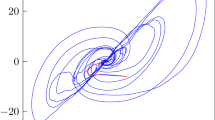Abstract
In the deterministic pitchfork bifurcation the dynamical behavior of the system changes as the parameter crosses the bifurcation point. The stable fixed point loses its stability. Two new stable fixed points appear. The respective domains of attraction of those two fixed points split the state space into two macroscopically distinct regions. It is shown here that this bifurcation of the dynamical behavior disappears as soon as additive white noise of arbitrarily small intensity is incorporated the model. The dynamical behavior of the disturbed system remains the same for all parameter values. In particular, the system has a (random) global attractor, and this attractor is a one-point set for all parameter values. For any parameter value all solutions converge to each other almost surely (uniformly in bounded sets). No splitting of the state space into distinct regions occurs, not even into random ones. This holds regardless of the intensity of the disturbance.
Similar content being viewed by others
REFERENCES
Arnold, L. (1998). Random Dynamical Systems, Springer, Berlin.
Arnold, L., and Boxler, P. (1992). Stochastic bifurcation: Instructive examples in dimension one. In Pinsky, M. A., and Wihstutz, V. (eds.), Diffusion Processes and Related Problems in Analysis, Vol. II. Stochastic Flows, Birkhäuser, Boston, pp. 241–255.
Arnold, L., and Crauel, H. (1991). Random dynamical systems. In Arnold, L., Crauel, H., and Eckmann, J. P. (eds.), Lyapunov Exponents, Proceedings, Oberwolfach 1990, Lecture Notes in Mathematics 1486, Springer, Berlin, pp. 1–22.
Arnold, L., and Scheutzow, M. (1995). Perfect cocycles through stochastic differential equations. Prob. Theory Relat. Fields 101, 65–88.
Baxendale, P. H. (1994). A stochastic Hopf bifurcation. Prob. Theory Relat. Fields 99, 581–616.
Castaing, C., and Valadier, M. (1977). Convex Analysis and Measurable Multifunctions, Lecture Notes in Mathematics 580, Springer, Berlin.
Crauel, H. (1990). Extremal exponents of random dynamical systems do not vanish. J. Dynam. Diff. Eq. 2, 245–291.
Crauel, H. (1991). Markov measures for random dynamical systems. Stochast. Stochast. Rep. 37, 153–173.
Crauel, H. (1995). Random Probability Measures on Polish Spaces, Habilitationsschrift, Bremen.
Crauel, H. (1998). Global random attractors are uniquely determined by attracting deterministic compact sets, to appear in Annali di Matematica.
Crauel, H., Debussche, A., and Flandoli, F. (1995). Random attractors. J. Dynam. Diff. Eqs. 9, 307–341.
Crauel, H., and Flandoli, F. (1994). Attractors for random dynamical systems. Prob. Theory Relat. Fields 100, 365–393.
Has'minski{ie274-1}, R. Z. (1980). Stochastic Stability of Differential Equations, Sijthoff & Noordhoff, Aalphen aan de Rijn.
Horsthemke, W., and Lefever, R. (1984). Noise-Induced Transitions. Theory and Applications in Physics, Chemistry and Biology, Springer, Berlin.
Ichihara, K., and Kunita, H. (1974). A classification of the second order degenerate elliptic operators and its probabilistic characterization. Z. Wahrscheinlichkeitstheorie Verw. Gebiete 30, 235–254, (1977). 39, 81–84 (supplements).
Temam, R. (1988). Infinite-Dimensional Dynamical Systems in Mechanics and Physics, Springer, New York.
Author information
Authors and Affiliations
Rights and permissions
About this article
Cite this article
Crauel, H., Flandoli, F. Additive Noise Destroys a Pitchfork Bifurcation. Journal of Dynamics and Differential Equations 10, 259–274 (1998). https://doi.org/10.1023/A:1022665916629
Issue Date:
DOI: https://doi.org/10.1023/A:1022665916629




